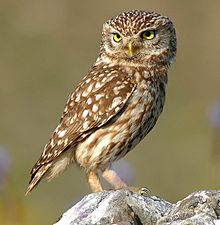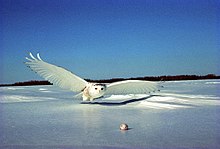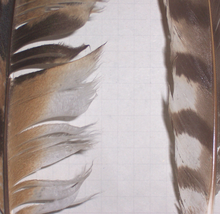Wednesday, February 28, 2018
Tuesday, February 27, 2018
Toad Tuesdays
From Wikipedia, the free encyclopedia.

| Owl Temporal range: Late Paleocene to recent 30–0 Ma | |
|---|---|
 | |
| Little owl (Athene noctua) | |
| Otus jolandae call |
Owls are birds from the order Strigiformes, which includes about 200 species of mostly solitary and nocturnal birds of prey typified by an upright stance, a large, broad head, binocular vision, binaural hearing, sharp talons, and feathers adapted for silent flight. Exceptions include the diurnal northern hawk-owl and the gregarious burrowing owl.
Owls hunt mostly small mammals, insects, and other birds, although a few species specialize in hunting fish. They are found in all regions of the Earth except Antarctica and some remote islands.
Owls are divided into two families: the true (or typical) owl family, Strigidae, and the barn-owl family, Tytonidae...
Anatomy
Owls possess large, forward-facing eyes and ear-holes, a hawk-like beak, a flat face, and usually a conspicuous circle of feathers, a facial disc, around each eye. The feathers making up this disc can be adjusted to sharply focus sounds from varying distances onto the owls' asymmetrically placed ear cavities. Most birds of prey have eyes on the sides of their heads, but the stereoscopic nature of the owl's forward-facing eyes permits the greater sense of depth perception necessary for low-light hunting. Although owls have binocular vision, their large eyes are fixed in their sockets—as are those of most other birds—so they must turn their entire heads to change views. As owls are farsighted, they are unable to clearly see anything within a few centimeters of their eyes. Caught prey can be felt by owls with the use of filoplumes—hairlike feathers on the beak and feet that act as "feelers". Their far vision, particularly in low light, is exceptionally good.
Owls can rotate their heads and necks as much as 270°. Owls have 14 neck vertebrae compared to seven in humans, which makes their necks more flexible. They also have adaptations to their circulatory systems, permitting rotation without cutting off blood to the brain: the foramina in their vertebrae through which the vertebral arteries pass are about 10 times the diameter of the artery, instead of about the same size as the artery as in humans; the vertebral arteries enter the cervical vertebrae higher than in other birds, giving the vessels some slack, and the carotid arteries unite in a very large anastomosis or junction, the largest of any bird's, preventing blood supply from being cut off while they rotate their necks. Other anastomoses between the carotid and vertebral arteries support this effect.[1][2]
The smallest owl—weighing as little as 31 g (1 oz) and measuring some 13.5 cm (5 in)—is the elf owl (Micrathene whitneyi).[3]Around the same diminutive length, although slightly heavier, are the lesser known long-whiskered owlet (Xenoglaux loweryi) and Tamaulipas pygmy owl (Glaucidium sanchezi).[3] The largest owls are two similarly sized eagle owls; the Eurasian eagle-owl (Bubo bubo) and Blakiston's fish owl (Bubo blakistoni). The largest females of these species are 71 cm (28 in) long, have 54 cm (21 in) long wings, and weigh 4.2 kg (9.3 lb).[3][4][5][6][7]
Different species of owls produce different sounds; this distribution of calls aids owls in finding mates or announcing their presence to potential competitors, and also aids ornithologists and birders in locating these birds and distinguishing species. As noted above, their facial discs help owls to funnel the sound of prey to their ears. In many species, these discs are placed asymmetrically, for better directional location.
Owl plumage is generally cryptic, although several species have facial and head markings, including face masks, ear tufts, and brightly coloured irises. These markings are generally more common in species inhabiting open habitats, and are thought to be used in signaling with other owls in low-light conditions.[8]
...
Z
Adaptations for hunting
All owls are carnivorous birds of prey and live mainly on a diet of insects and small rodents such as mice, rats, and hares. Some owls are also specifically adapted to hunt fish. They are very adept in hunting in their respective environments. Since owls can be found in nearly all parts of the world and across a multitude of ecosystems, their hunting skills and characteristics vary slightly from species to species, though most characteristics are shared among all species.[citation needed]
Flight and feathers
Most owls share an innate ability to fly almost silently and also more slowly in comparison to other birds of prey. Most owls live a mainly nocturnal lifestyle and being able to fly without making any noise gives them a strong advantage over their prey that are listening for the slightest sound in the night. A silent, slow flight is not as necessary for diurnal and crepuscular owls given that prey can usually see an owl approaching. While the morphological and biological mechanisms of this silent flight are more or less unknown, the structure of the feather has been heavily studied and accredited to a large portion of why they have this ability. Owls’ feathers are generally larger than the average birds’ feathers, have fewer radiates, longer pennulum, and achieve smooth edges with different rachis structures.[12] Serrated edges along the owl’s remiges bring the flapping of the wing down to a nearly silent mechanism. The serrations are more likely reducing aerodynamic disturbances, rather than simply reducing noise.[12] The surface of the flight feathers is covered with a velvety structure that absorbs the sound of the wing moving. These unique structures reduce noise frequencies above 2 kHz,[13] making the sound level emitted drop below the typical hearing spectrum of the owl’s usual prey[13][14] and also within the owl’s own best hearing range.[citation needed] This optimizes the owl’s ability to silently fly to capture prey without the prey hearing the owl first as it flies in. It also allows the owl to monitor the sound output from its flight pattern.
The feather adaption that allows silent flight means that barn owl feathers are not waterproof. To retain the softness and silent flight, the barn owl cannot use the preen oil or powder dust that other species use for waterproofing. In wet weather, they cannot hunt and this may be disastrous during the breeding season. Barn owls are frequently found drowned in cattle drinking troughs, since they land to drink and bathe, but are unable to climb out. Owls can struggle to keep warm, because of their lack of waterproofing, so large numbers of downy feathers help them to retain body heat.[15]
Vision
Eyesight is a particular characteristic of the owl that aids in nocturnal prey capture. Owls are part of a small group of birds that live nocturnally, but do not use echolocation to guide them in flight in low-light situations. Owls are known for their disproportionally large eyes in comparison to their skulls. An apparent consequence of the evolution of an absolutely large eye in a relatively small skull is that the eye of the owl has become tubular in shape. This shape is found in other so-called nocturnal eyes, such as the eyes of strepsirrhine primates and bathypelagic fishes.[16] Since the eyes are fixed into these sclerotic tubes, they are unable to move the eyes in any direction.[17] Instead of moving their eyes, owls swivel their heads to view their surroundings. Owls' heads are capable of swiveling through an angle of roughly 270°, easily enabling them to see behind them without relocating the torso.[17] This ability keeps bodily movement at a minimum, thus reduces the amount of sound the owl makes as it waits for its prey. Owls are regarded as having the most frontally placed eyes among all avian groups, which gives them some of the largest binocular fields of vision. However, owls are farsighted and cannot focus on objects within a few centimeters of their eyes.[16][18] While owls are commonly believed to have great nocturnal vision due to their large (thus very light-gathering) eyes and pupils and/or extremely sensitive rod receptors, the true cause for their ability to see in the night is due to neural mechanisms which mediate the extraction of spatial information gathered from the retinal image throughout the nocturnal luminance range. These mechanisms are only able to function due to the large-sized retinal image.[19] Thus, the primary nocturnal function in the vision of the owl is due to its large posterior nodal distance; retinal image brightness is only maximized to the owl within secondary neural functions.[19] These attributes of the owl cause its nocturnal eyesight to be far superior to that of its average prey.[19]
Hearing
Owls exhibit specialized hearing functions and ear shapes that also aid in hunting. They are noted for asymmetrical ear placements on the skull in some genera. Owls can have either internal or external ears, both of which are asymmetrical. Asymmetry has not been reported to extend to the middle or internal ear of the owl. Asymmetrical ear placement on the skull allows the owl to pinpoint the location of its prey. This is especially true for strictly nocturnal species such as the barn owls Tyto or Tengmalm's owl.[17] With ears set at different places on its skull, an owl is able to determine the direction from which the sound is coming by the minute difference in time that it takes for the sound waves to penetrate the left and right ears.[citation needed] The owl turns its head until the sound reaches both ears at the same time, at which point it is directly facing the source of the sound. This time difference between ears is a matter of about 0.00003 seconds, or 30 millionths of a second. Behind the ear openings are modified, dense feathers, densely packed to form a facial ruff, which creates an anterior-facing, concave wall that cups the sound into the ear structure.[20] This facial ruff is poorly defined in some species, and prominent, nearly encircling the face, in other species. The facial disk also acts to direct sound into the ears, and a downward-facing, sharply triangular beak minimizes sound reflection away from the face. The shape of the facial disk is adjustable at will to focus sounds more effectively.[17]
The prominences above a great horned owl's head are commonly mistaken as its ears. This is not the case; they are merely feather tufts. The ears are on the sides of the head in the usual location (in two different locations as described above).
Talons
While the auditory and visual capabilities of the owl allow it to locate and pursue its prey, the talons and beak of the owl do the final work. The owl kills its prey using these talons to crush the skull and knead the body.[17] The crushing power of an owl’s talons varies according to prey size and type, and by the size of the owl. The burrowing owl (Athene cunicularia), a small, partly insectivorous owl, has a release force of only 5 N. The larger barn owl (Tyto alba) needs a force of 30 N to release its prey, and one of the largest owls, the great horned owl (Bubo virginianus) needs a force over 130 N to release prey in its talons.[21] An owl’s talons, like those of most birds of prey, can seem massive in comparison to the body size outside of flight. The masked owl has some of the proportionally longest talons of any bird of prey; they appear enormous in comparison to the body when fully extended to grasp prey.[22] An owl’s claws are sharp and curved. The family Tytonidae has inner and central toes of about equal length, while the family Strigidae has an inner toe that is distinctly shorter than the central one.[21] These different morphologies allow efficiency in capturing prey specific to the different environments they inhabit.
Beak
The beak of the owl is short, curved, and downward-facing, and typically hooked at the tip for gripping and tearing its prey. Once prey is captured, the scissor motion of the top and lower bill is used to tear the tissue and kill. The sharp lower edge of the upper bill works in coordination with the sharp upper edge of the lower bill to deliver this motion. The downward-facing beak allows the owl’s field of vision to be clear, as well as directing sound into the ears without deflecting sound waves away from the face.[citation needed]
Camouflage
The coloration of the owl’s plumage plays a key role in its ability to sit still and blend into the environment, making it nearly invisible to prey. Owls tend to mimic the colorations and sometimes even the texture patterns of their surroundings, the common barn owl being an exception. Nyctea scandiaca, or the snowy owl, appears nearly bleach-white in color with a few flecks of black, mimicking their snowy surroundings perfectly. Likewise, the mottled wood-owl (Strix ocellata) displays shades of brown, tan, and black, making the owl nearly invisible in the surrounding trees, especially from behind. Usually, the only tell-tale sign of a perched owl is its vocalizations or its vividly colored eyes.
Behavior

Owl eyes each have nictitating membranes that can move independently of each other, as seen on this spotted eagle-owl in Johannesburg, South Africa.
Most owls are nocturnal, actively hunting their prey in darkness. Several types of owls, however, are crepuscular—active during the twilight hours of dawn and dusk; one example is the pygmy owl (Glaucidium). A few owls are active during the day, also; examples are the burrowing owl (Speotyto cunicularia) and the short-eared owl (Asio flammeus).
Much of the owls' hunting strategy depends on stealth and surprise. Owls have at least two adaptations that aid them in achieving stealth. First, the dull coloration of their feathers can render them almost invisible under certain conditions. Secondly, serrated edges on the leading edge of owls' remiges muffle an owl's wing beats, allowing an owl's flight to be practically silent. Some fish-eating owls, for which silence has no evolutionary advantage, lack this adaptation.
An owl's sharp beak and powerful talons allow it to kill its prey before swallowing it whole (if it is not too big). Scientists studying the diets of owls are helped by their habit of regurgitating the indigestible parts of their prey (such as bones, scales, and fur) in the form of pellets. These "owl pellets" are plentiful and easy to interpret, and are often sold by companies to schools for dissection by students as a lesson in biology and ecology.[23
Monday, February 26, 2018
Molly and Todd on Monday
Molly here,
The weather is cold.
We have been watching out the window.
The yard has been covered with ice and some snow.
Todd watches and I watch B G as he takes pictures.
Then Todd also looks over to see B G and then he goes back to looking out the window.
Then we were looking out and there was a half moon. It was really spectacular.
He got 4 pictures that night but there were only two of them that were good.
Then we have some more pictures of us.
Thanks for stopping to see us. We are glad it that you come to see us each week.
Woof!
The weather is cold.
We have been watching out the window.
The yard has been covered with ice and some snow.
Todd watches and I watch B G as he takes pictures.
Then Todd also looks over to see B G and then he goes back to looking out the window.
Then we have some more pictures of us.
Thanks for stopping to see us. We are glad it that you come to see us each week.
Woof!
Sunday, February 25, 2018
Aparian
"Were I to be the founder of a new sect,
I would call them Apiarians, and, after the example of the bee,
advise them to extract the honey of every sect."
- Thomas Jefferson
"And the peace which I always found in the silence and emptiness
of the moors filled me utterly."
~James Herriot (1916-1995)
"Peace is not something you wish for,
it is something you make, something you are,
something you do, and something you give away.”
~Robert Fulghum
“The mind can go in a thousand directions, but on this beautiful path,
I walk in peace. With each step, the wind blows.
With each step, a flower blooms.”
~Thich Nhat Hanh
“Peace is the only battle worth waging.”
~Albert Camus
“For a day, just for one day,
Talk about that which disturbs no one
And bring some peace into your
Beautiful eyes.”
~Hafez
"I discovered the secret of the sea
in meditation upon a dewdrop."
~Khalil Gibran (1883-1931)
Hope is being able to see that there is light
despite all of the darkness.
-Desmond Tutu
“The practice of forgiveness is our most important
contribution to the healing of the world.”
~Marianne Williamson
You find peace not by rearranging the circumstances of your life,
but by realizing who you are at the deepest level.”
~Eckhart Tolle
“To replace the old paradigm of war with a new paradigm
of waging peace, we must be pioneers who can push
the boundaries of human understanding.
We must be doctors who can cure the virus of violence.
We must be soldiers of peace who can do more
than preach to the choir. And we must be artists
who will make the world our masterpiece.”
~Paul Chappell
Subscribe to:
Posts (Atom)







































